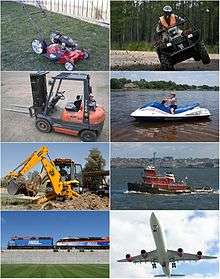Non-road engine

Non-road engine (which may include non-road equipment and non-road vehicle) is an internal combustion engine or a gas turbine engine used for other purposes than being an engine of a vehicle operated on public roadways. The term is commonly used by regulators to classify the engines in order to control their emission. Non-road engines are used in an extremely wide range of applications which may include machinery and engines of vehicles in other modes of transportation with different fuel types such as gasoline and diesel fuel.[1][2] In many jurisdictions, the term non-road engine is assumed to refer to the engines that have mobility or portability which is separated from the term stationary engine.[3] The definition of non-road engine may explicitly exclude certain non-road vehicles such as aircraft, locomotives, and ocean-going marine vessels.[4] In Europe, the regulations are specifically clarified on the mobility by using the term non-road mobile machinery (NRMM).[5] In Australia, the definition includes some stationary engines such as electric generators and pumps.[6]
Classifications
There are many classifications of the non-road engines based on the jurisdictions. The following are common classifications:[1][6]
- Lawn mowers and garden equipment
- Snowmobiles, dirt bikes, and all-terrain vehicles
- Forklifts, generators, and compressors using gasoline or propane
- Recreational boats and personal watercraft
- Nonroad diesel engines (machinery) in construction and agricultural equipment such as backhoes and tractors. Other equipment are included such as ground support equipment, and heavy forklifts, generators and pumps that use diesel engines.
- Marine diesel engine
- Locomotive
- Aircraft engine
In certain jurisdictions, the non-road engines may include stationary engines that are diesel powered.[3]
Emission standards
The rationale for establishing emission standards for non-road engines is that they are a significant source of pollution. The engines of on-road vehicles have advanced emission controls which are not found on those non-road engines. The non-road engines also emit air pollution particles at much higher rates.[6]
The emission standards are based on the engine classifications and vary in various jurisdictions. The main model regulations that are used by many countries are the United States Environmental Protection Agency through the section 213 of the Clean Air Act (42 U.S.C. 7547) and the directive of the European Commission (the "mother Directive 97/68/EC, the amendments Directive 2002/88/EC, Directive 2004/26/EC, Directive 2006/105/EC, Directive 2011/88/EU and the last amendment Directive 2012/46/EU). The directives cover diesel engines, spark-ignition engines, constant-speed engines, railcars, locomotives and inland waterway vessels.[3][5]
Conformance outside the USA and EU
The standards for non-road diesel engines are more harmonized. Many countries adopt the emission standards derived from either the US or the European models.
Canada adopted the US standards in 1999. Korea modeled its Tier 2 standards from the US Tier 2. Russia adopted the European Stage I standards. Turkey adopted the European standards but with different implementation dates. China adopted the European Stage I/II standards in 2007.
India introduced its own standards in 2006 called Bharat (CEV) Stage II (based in part on European Stage I) and Bharat (CEV) Stage III (based on US Tier 2/3). Japan introduced its own standards that are similar but not harmonized to the US Tier 3 and Europe Stage III A. Brazil adopted the resolution in 2011 to set emission standards that are equivalent to US Tier 3 and European Stage III A.[3]
See also
References
- 1 2 "Nonroad Engines, Equipment, and Vehicles". US Environment Protection Agency. Retrieved 24 December 2013.
- ↑ "Nonroad Engine Population Estimates" US Environment Protection Agency. Retrieved 27 April 2014.
- 1 2 3 4 "2013 Global Sourcing Guide" (PDF). Diesel & Gas Turbine Publications. Retrieved 24 December 2013.
- ↑ "2005 Nonroad Engine Fleet Characterization in the Canadian Lower Fraser Valley" (PDF). RWDI AIR Inc. p. i. Retrieved 24 December 2013.
- 1 2 "Emissions from non-road mobile machinery". Enterprise and Industry DG, European Commission. Retrieved 20 December 2016.
- 1 2 3 "Non-road engines". Department of the Environment, Australian Government. Retrieved 24 December 2013.